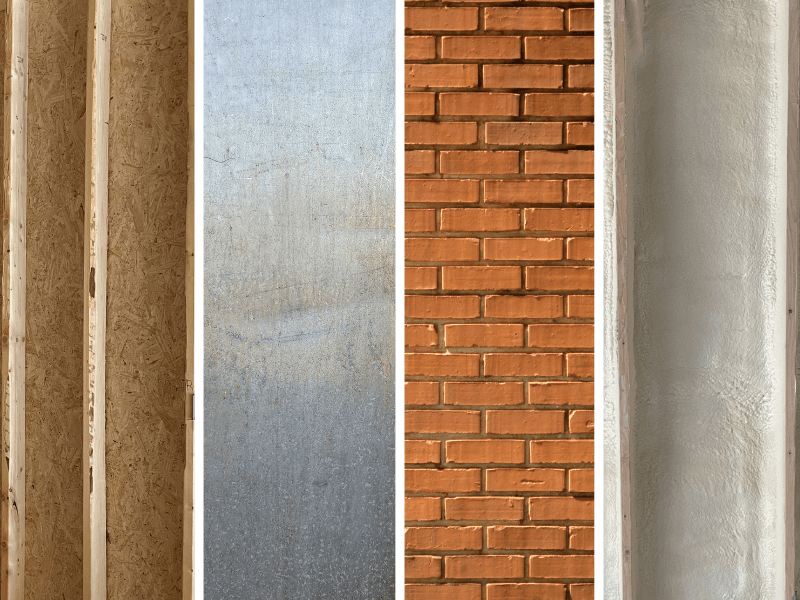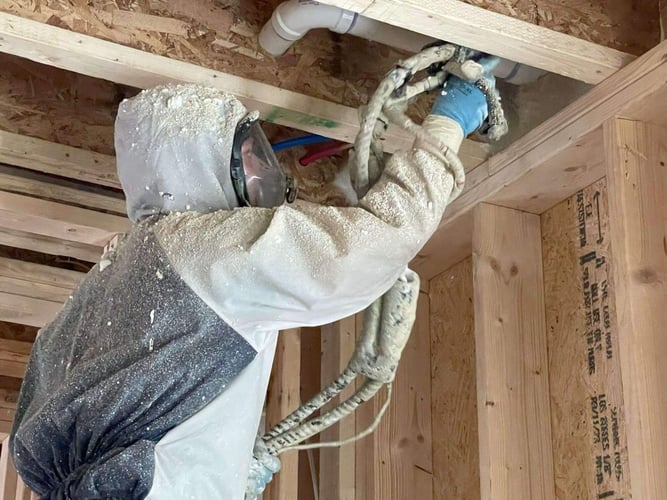What Does Spray Foam Stick To? Spray Foam Insulation Application Guide
October 18th, 2023
5 min read
By Kilian Agha

You want to install spray foam for a project. Whether you’re planning to hire a professional or have a DIY kit stashed in your garage, you want to make sure that spray foam is an option for what you have in mind. Will the product stick? Are there any parameters you must meet for the foam to work?
South Central Services has installed spray foam insulation in hundreds of homes. It’s our job to know what we can spray against and under what conditions. This article will share that wisdom with you.
By the end of this article, you will know:
- What substrates spray foam insulation can be sprayed against
- How climate zone impacts substrates and foams
- What conditions must be met for spray foam to adhere successfully
- How to remove spray foam insulation after installation
Don't have time to read right now? Check out everything you need to know at a glance.
Substrates for Spray Foam Insulation
Substrate is the technical term for surfaces we install spray foam insulation against. Depending on the climate zone, either open cell or closed cell spray foam can be used against certain substrates.
This application guide is specific to Climate Zone 5, which includes locations like southern Pennsylvania, Maryland, Virginia, and West Virginia. Generally, the further south you go, the greater the versatility of open cell spray foam applications. As the climate changes and weather patterns become less extreme, the need for a vapor barrier becomes less relevant. Since open cell spray foam cannot create a vapor barrier, it often has more uses in southern climate zones. Contact a spray foam contractor in your area for specifics about open and closed cell foam for your climate zone.
Let’s examine the possible substrates for spray foam in Climate Zone 5.
Wood: A Substrate For Open And Closed Cell Spray Foam

Both closed and open cell spray foam can be applied to wood substrates. Wood is one of the most common building materials. Additionally, wood is not as conductive as metal or as porous as masonry. These features make it an ideal substrate for spray foam application.
Wooden substrates include exterior and interior wall cavities, rafters, and floor cavities. Whether a new building is commercial or residential, wood is likely involved.
Metal: A Substrate For Closed Cell Spray Foam

In our climate zone, Climate Zone 5, metal is a substrate only for closed cell spray foam.
As you move further south of Pennsylvania, the climate conditions may allow for open cell spray foam to be installed against metal. Warmer climate zones do not experience colder temperatures which can cause condensation issues.
Metal siding is one example of a metal substrate. Closed cell spray foam may also be installed against metal garage doors or sheds. If you’re curious about spray foam on a commercial metal roof, our friends at GIDEON have an excellent breakdown of the pros and cons of spray foam in commercial roofing applications.
Stones & Underslab: Substrates For Closed Cell Spray Foam
%20(F).jpg?width=667&height=500&name=7.10.24%20Spray%20Faom%20(2)%20(F).jpg)
Closed cell spray foam can be used in below-grade applications and adheres well to stones and underslab. Closed cell can be installed when foundations are poured for a new building.
Old concrete can also have spray foam insulation installed, as long as the concrete does not have any residue that could prohibit adhesion. We insulate building foundations to help control temperature changes from the root of the building.
Open cell spray foam is not an option for stones and underslab because it is not approved for below-grade applications. Below-grade applications are below the ground where moisture and vapor are prevalent.
Open cell spray foam does not have the necessary cell structure to handle moisture. Think of open cell spray foam like a sponge. Its cell structure has a sponge-like texture, which means it is prone to absorbing water.
Masonry, Concrete, & Brick: Substrates For Closed Cell Spray Foam

These substrates are not always located in below-grade locations. Homes may have exterior brick or masonry walls. However, all three of these are materials that transmit vapor. For this reason, closed cell spray foam is recommended for masonry, concrete, and brick applications.
Closed cell spray foam has a vapor barrier that allows it to handle amounts of moisture content in a gaseous state. Open cell spray foam does not have vapor barrier capabilities. This key difference is due to the different cellular structures of open and closed cell foam. While open cell spray foam can be compared to a sponge, closed cell is more like a stiff foam board.
For most of our service area, open cell cannot be installed on these substrates. Towns like Chambersburg, PA and Berkeley Springs, WV have distinct weather patterns and low winter temperatures. Climates with cold winters generally need vapor barriers.
Closed Cell Spray Foam: A Substrate For Open And Closed Cell Spray Foam

Spray foam can be installed on top of itself. Closed cell spray foam insulation is a suitable substrate for additional closed or open cell spray foam.
If an installer left too thin of a layer of closed cell foam, more foam could be installed on top to make the insulation effective. Or, to save money, sometimes a thin layer of closed cell is installed for its technical properties, and the remaining insulation layer is made up of less expensive open cell.
For homeowners on a budget, this method can be a great way to cut costs without sacrificing performance.
Necessary Substrate Conditions
Spray foam insulation can only adhere to substrates when certain conditions are met. For example, if a substrate has more than 15% moisture content, the foam will not stick.
The temperature of the substrate also needs to be considered when factoring in the temperature of the foam. The temperature parameters for proper adhesion are relative to each foam product.
Installers know the range of temperatures for the foam they are spraying to be safely installed. When a substrate is too cold for the foam to adhere, we sometimes heat the substrate or add heat into the space.
Regardless of what temperature the substrate is, we almost always adjust the foam component temperatures.
How To Remove Spray Foam Insulation
Removing spray foam insulation requires no special products, as long as the foam was installed on-ratio. Open cell spray foam has a less rigid consistency, so it can be torn from a wall or floor cavity if you need to remove it. Closed cell spray foam is more rigid and will take more elbow grease to dig out.
If you intend to install more spray foam insulation on the substrate, you must scrape out the cavity. It does not need to be perfectly clean to adhere well, but the only foam that should be remaining is a safe, effective, on-ratio foam.
Off-ratio spray foam is difficult for homeowners to diagnose. The clearest indicators would be a foam tacky to the touch, or a foam emitting a strong chemical odor long after it was installed. Off-ratio foam may require chemical products to remove due to stickiness or tackiness. If you remove off-ratio foam to reinstall spray foam insulation, all off-ratio foam must be scraped from the substrate. Off-ratio foam could cause adhesion issues, but more importantly, it is a health risk.
The Bottom Line About Where Spray Foam Can Be Installed
Depending on the substrate, either open cell or closed cell spray foam can be installed for building applications. Under appropriate conditions, spray foam insulation can adhere to almost any surface and create an airtight seal. On-ratio spray foam should not need to be removed but can be removed without chemical treatments.
Here is a chart summarizing the applications and substrates for open and closed cell spray foam in Climate Zone 5.
 This chart is accurate for readers within an hour's drive of Franklin County, PA. If you live further south, check with a professional spray foam contractor near you about how the climate impacts possible applications for spray foam.
This chart is accurate for readers within an hour's drive of Franklin County, PA. If you live further south, check with a professional spray foam contractor near you about how the climate impacts possible applications for spray foam.
Now that you know what spray foam adheres to, your next step is to:
- Find a reliable spray foam insulation contractor
- Compare DIY and professionally-installed spray foam
- Discover when spray foam insulation should not be used in a home
Disclaimer: While we strive to publish information accurate to building science, local building codes and standards supersede our recommendations.
Kilian has co-owned and operated South Central Services for 8 years. He is passionate about community involvement. In his spare time, he enjoys being with his family, playing ice hockey, and going fishing with friends.
Topics:


